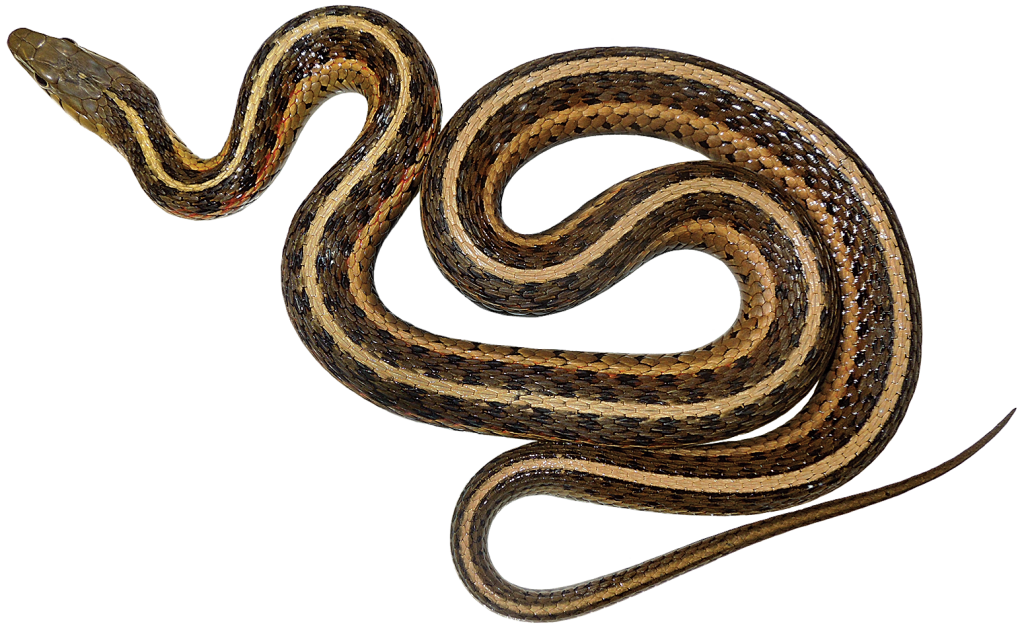1a. Pit between eye and nostril on each side of head; most scales on underside of tail in a single row (Fig. 23a) … 2
1b. Pit between eye and nostril absent; scales on underside of tail in 2 rows (Fig. 23b) … 5

2a. Tail ending in rattle or horny button; tail tip not yellow … 3
2b. Tail not ending in rattle or horny button; tail tip yellow in juveniles … 4
3a. Four large scales on top of head in front of eyes (Fig. 24a) … Eastern Massasauga
3b. Numerous small scales on top of head in front of eyes (Fig. 24b) … Timber Rattlesnake
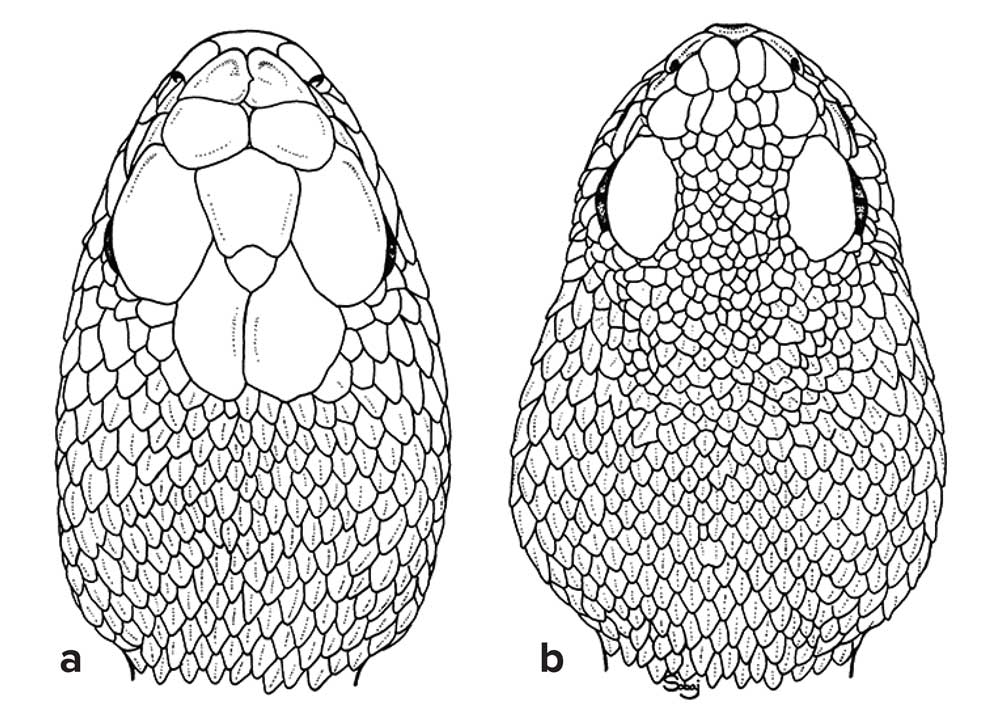
4a. Dorsum with dark brown, hourglass-shaped saddles; head without black stripe behind each eye; upper lip without white line … Eastern Copperhead
4b. Dorsum markings, if present, faint or obscured by dark brown or black ground color; head with black stripe behind each eye; upper lip with white line … Northern Cottonmouth
5a. Some or all dorsal scales keeled (Fig. 25a) … 6
5b. All scales smooth (Fig. 25b) … 29
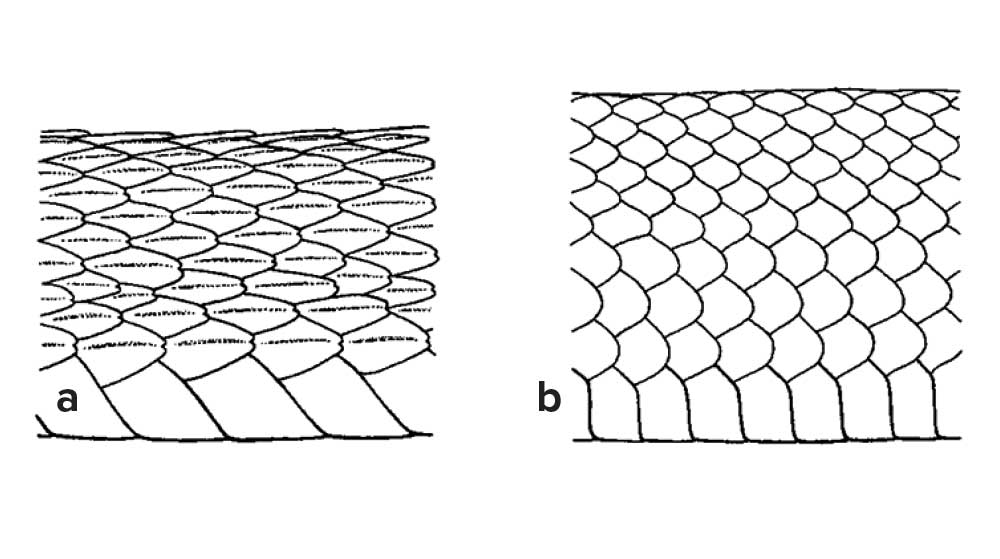
6a. Anal plate divided (Fig. 26a) … 7
6b. Anal plate entire (Fig. 26b) … 23
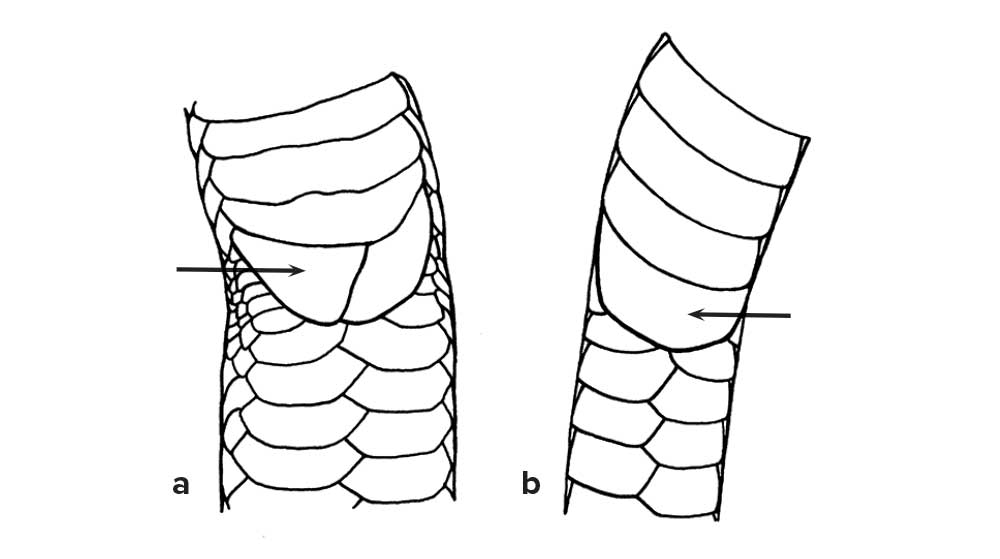
7a. Rostral scale (Fig. 27) upturned and keeled … 8
7b. Rostral scale (Fig. 27) not upturned or keeled … 9
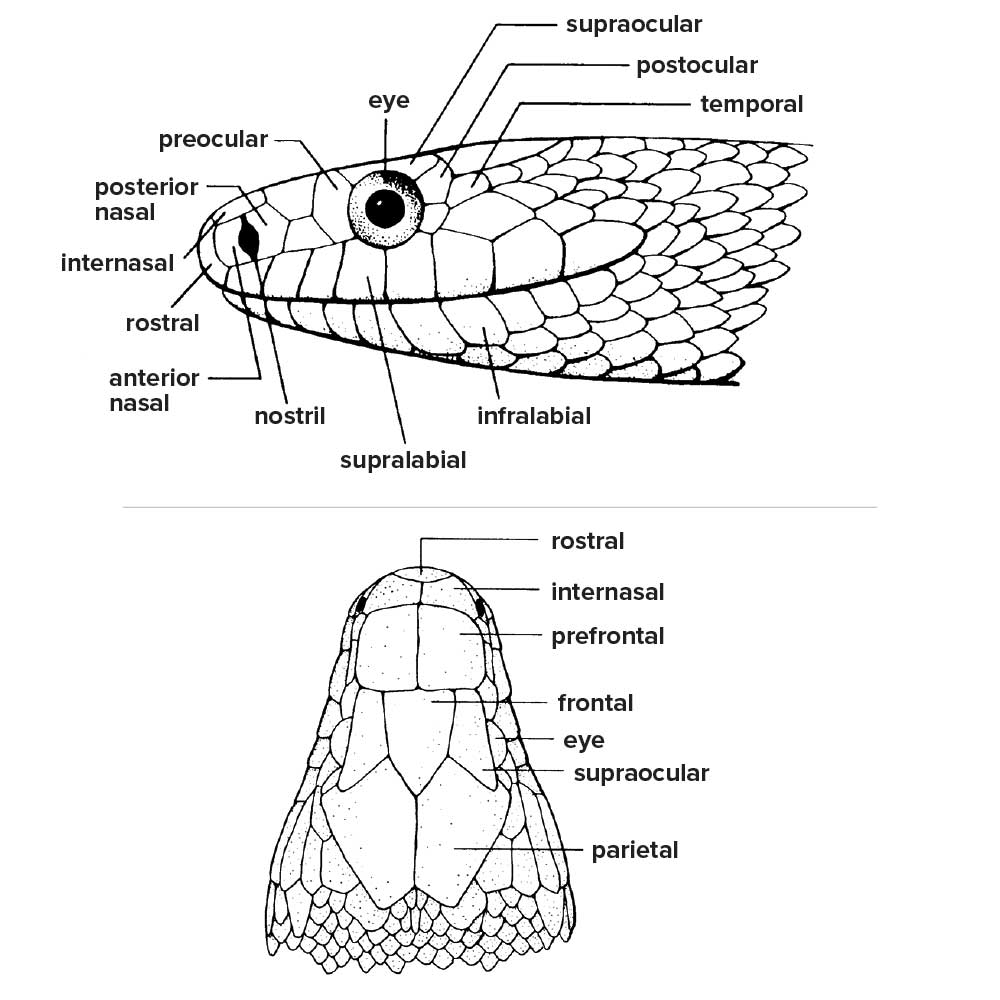
8a. Rostral scale (Fig. 27) pointed and only slightly upturned; underside of tail lighter than rest of venter … Eastern Hog-nosed Snake
8b. Rostral scale (Fig. 27) strongly upturned; underside of tail as dark as rest of venter … Plains Hog-nosed Snake
9a. Loreal scale absent (Fig. 28a) … 10
9b. Loreal scale present (Fig. 28b) … 11

10a. Dorsal scale rows at midbody (Fig. 29) number 15; light spots on rear of head; venter orange or red … Red-bellied Snake
10b. Dorsal scale rows at midbody (Fig. 29) number 17; light spots on head only in juveniles; venter white or pink … Dekay’s Brown Snake

11a. One internasal scale (Fig. 30a); supralabials number 6 on each side of the head; postoculars number 2 on each side of the head; dorsal scales may be only weakly keeled … Smooth Earthsnake
11b. Two internasal scales (Fig. 30b) … 12

12a. Dorsal scale rows (Fig. 29) at midbody number 17; dorsal color green … Rough Greensnake
12b. Dorsal scale rows (Fig. 29) more than 17; dorsal color not green … 13
13a. Dorsal scales weakly keeled; postocular scales (Fig. 23) 2; dorsal scale rows (Fig. 29) number 25-33 … 14
13b. Dorsal scales strongly keeled (Fig. 26a); postocular scales (Fig. 23) 2 or 3; dorsal scale rows (Fig. 29) 25 or fewer … 16
14a. Head gray with reddish-brown spearpoint marking between eyes; venter pattern white with small gray squares … Great Plains Ratsnake
14b. No marking between eyes; venter pattern not as above … 15
15a. Ventral pattern yellow with large dark brown squares; ventral scales (Fig. 31) fewer than 220 … Eastern Foxsnake
15b. Ventral pattern black-and-white checkerboard anteriorly; ventral scales (Fig. 31) more than 220 … Gray Ratsnake

16a. Dorsal scale rows at midbody (Fig. 29) number 19 … 17
16b. Dorsal scale rows at midbody (Fig. 29) number more than 19 … 19
17a. Dorsum with 4 rows of black spots; venter pink or reddish with a row of black spots along each side; preocular scales (Fig. 27) number 1 on each side of head … Kirtland’s Snake
17b. Dorsum without dark spots; venter plain or striped anteriorly and not red; preocular scales (Fig. 27) number 2 on each side of head … 18
18a. Venter entirely yellow or yellow with 1 thin median stripe … Graham’s Crayfish Snake
18b. Venter entirely dark brown or brown with 2 median stripes … Queensnake
19a. Dorsal scale rows at midbody (Fig. 29) number 27 to 33 … 20
19b. Dorsal scale rows at midbody (Fig. 29) 25 or fewer … 21
20a. Subocular scales number 1 or 2 (Fig. 32a); dorsum dark olive-brown; venter dark with light spots … Mississippi Green Watersnake
20b. Subocular scales absent (Fig. 32b); dorsum with chainlike pattern; venter yellow with dark spots … Diamond-backed Watersnake
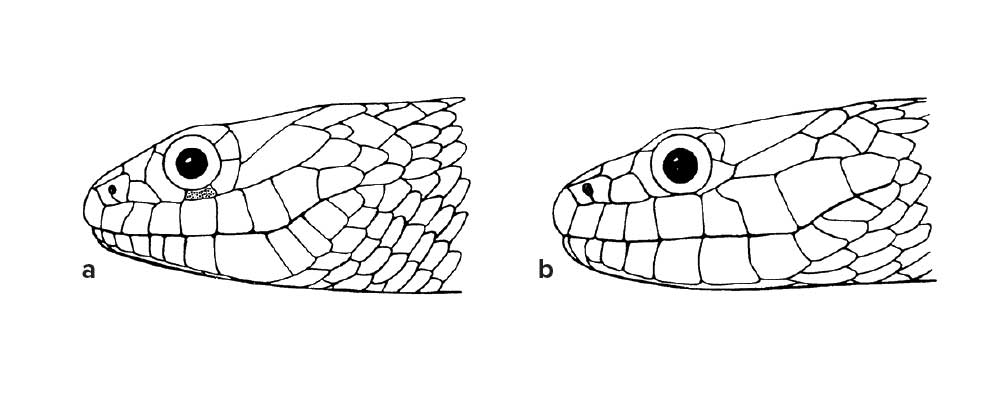
21a. Venter yellow or red with no markings … Plain-bellied Watersnake
21b. Venter marked with black or brown spots or blotches … 22
22a. Dorsal bands number fewer than 20; venter light yellow with irregular reddish-brown markings … Southern Watersnake
22b. Dorsal bands number more than 20; venter light yellow with small red or brown spots or half-moons … Common Watersnake
23a.Dorsal scale rows at mid-body (Fig. 29) number 27 or more; dorsum boldly blotched; prefrontal scales (Fig. 27) number 3 or more; longitudinal stripes absent … Gophersnake
23b. Dorsal scale rows at mid-body (Fig. 29) number fewer than 27; dorsum without blotches; prefrontal scales (Fig. 27) number 2; longitudinal stripes usually present … 24
24a. Infralabial scales (Fig. 27) number 8 or more … 25
24b. Infralabial scales (Fig. 27) number fewer than 8 … 28
25a. Lateral stripe not touching fourth scale row; parietal scales (Fig. 27) without light spots … Common Gartersnake
25b. Lateral stripe on fourth scale row, at least anteriorly; parietal scales (Fig. 27) with light spot in each … 26
26a. Stout-bodied; tail length usually less than 27% of total length; supralabial scales (Fig. 27) with black bars … Plains Gartersnake
26b. Slender-bodied; tail usually 27% or more of total length; supralabial scales (Fig. 27) without black bars … 27
27a. Parietal scales (Fig. 27) with large, bright spots that usually touch each other; supralabial scales (Fig. 27) usually number 8; brown lateral stripe absent … Western Ribbonsnake
27b. Parietal scales (Fig. 27) with faint spots that never touch each other; supralabial scales (Fig. 27) usually number 7; brown lateral stripe on first scale row extends slightly onto venter … Eastern Ribbonsnake
28a. Dorsum and venter unmarked; dorsal scales may be only weakly keeled … Smooth Earthsnake
28b. Dorsum with longitudinal light stripes; venter with 2 rows of black spots down the center … Lined Snake
29a. Anal plate divided (Fig. 26a) … 30
29b. Anal plate entire (Fig. 26b) … 37
30a. Neck with light-colored ring … Ring-necked Snake
30b. Neck without light-colored ring … 31
31a. Dorsal scale rows at midbody (Fig. 29) number 15 or fewer … 32
31b. Dorsal scale rows at midbody (Fig. 29) number 17 or more … 34
32a. Dorsal scale rows at midbody (Fig. 29) number 13; dark dorsal color in strong contrast to pink belly … Common Wormsnake
32b. Dorsal scale rows at midbody (Fig. 29) number 15 … 33
33a. Loreal scale absent (Fig. 28a); dorsum tan; venter salmon pink; head flattened and usually darker than body … Flat-headed Snake
33b. Loreal scale present (Fig. 28b); dorsum grass green; venter yellow; head not flattened nor darker than body … Smooth Greensnake
34a. Dorsal scale rows at midbody (Fig. 29) number 19; venter black with transverse red bands; tail ending in a horny tip … Red-bellied Mudsnake
34b. Dorsal scale rows at midbody (Fig. 29) number 17; venter without red bands; tail not ending in a horny tip … 35
35a. Preocular scale (Fig. 27) absent; usually six supralabial scales; venter white or cream, some dorsal scales may be weakly keeled… Smooth Earthsnake
35b. Preocular scale (Fig. 27) present … 36
36a. Dorsal scale rows (Fig. 29) number 15 at posterior end of body; dorsal coloration uniform and varies from black to green; venter white or cream; tail scales not patterned like a braided whip … North American Racer
36b. Dorsal scale rows (Fig. 29) number 13 or fewer at posterior end of body; dorsal coloration uniformly black; venter uniformly black, becoming lighter under tail; tail scales patterned like a braided whip … Coachwhip
37a. Dorsal pattern of white or yellow dots on black ground … Common Kingsnake
37b. Dorsal pattern of distinct dark blotches on light ground … 38
38a. Dorsal scale rows at midbody (Fig. 29) number 25 or 27; ventral spots gray and indistinct against the greenish-yellow background; borders of dorsal blotches narrower than half a scale length … Prairie Kingsnake
38b. Dorsal scale rows at midbody (Fig. 29) usually number 21; ventral spots black and in sharp contrast to the white background; borders of dorsal blotches almost as wide as the length of one scale … Milksnake
